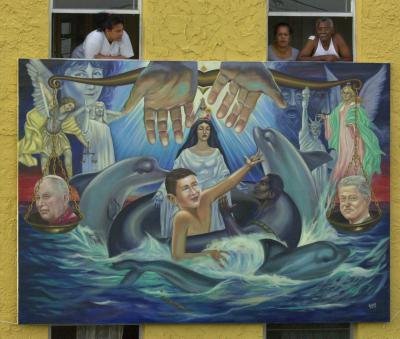Cuban woman tells tales of human smuggling
Ray Sanchez | Cuba notebook. Sun-Sentinel, September 16, 2007.
Word about potential smuggling voyages comes to her almost weekly, a 24-year-old woman named Adiany says.
Just last week, a friend informed her that two go-fast boats from South Florida would pick up 52 Cuban migrants along the northern coast. "This time it's a sure thing," the friend insisted.
Though anxious to be reunited with her husband in Miami, Adiany declined. The uncertainty and peril surrounding two of her previous trips worried her mother. "I don't think she can handle the stress," said Adiany, who asked that her full name not be used for fear of reprisals by Cuban police.
Adiany claims to have tried to leave the island 25 times. Cuban police have arrested her "numerous" times on her way to meet smugglers, and held her overnight, she said. Other times the boats failed to show up. Twice she has made it on board smuggling vessels, only to be intercepted by the U.S. Coast Guard and returned to Cuba.
"You try and you fail," said Adiany, who now contemplates flying to a Latin American country and entering the United States through Mexico. "Then you keep trying and trying until finally you make it."
The number of Cubans trying to leave the island appears to be rising, according to analysts and coast guard officials, who cite an increase in interdictions at sea this year. With slightly more than three months to year's end - as of Thursday - the Coast Guard has intercepted 2,467 Cuban migrants at sea, compared with a total of 2,293 in 2006. The current rate threatens to eclipse the 2,952 migrants intercepted in 2005, the largest one-year total since 1994, when 37,191 Cubans were picked up at sea during the rafter crisis.
Adiany attributed the surge to growing desperation among Cubans frustrated with economic disparities as well as U.S. and Cuban government polices that force the separation of families. Because she has been arrested for trying to leave Cuba, Adiany can no longer find work.
Her husband, Franscisco, left Cuba on a go-fast boat a year and a half ago. He lives in Miami, where he installs Direct TV equipment, work that helped him raise part of the $10,000 fee the smugglers will collect when they bring Adiany to Florida. He sends money to Adiany and her mother, but U.S. government limits the amount he can send to $100 per month.
Her mother has done her part to raise the smuggler's fee as well, illegally selling her home in Cuba and moving into a smaller house.
"Getting to Florida becomes an obsession," Adiany said. "The desperation is so great."
Adiany calmly described the disturbing first moments of the perilous journeys. As many as two dozen people wait in water up to their necks or deeper for the boat to arrive. When it does, "People climb over you," she said. "I was pushed underwater. People stepped on me. It's a human stampede. No one cares. There is no control."
A friend of Adiany provided similar accounts. Emilia, a 21-year-old Cuban who twice crossed the Florida Straits with Adiany, said smugglers attempt to maintain order by requesting that women and children board first, but to no avail.
"The men are the first to climb up," Emilia said in a phone interview. "Only then do they try to help others. Everyone fears that the Cuban coast guard will show up and they'll be left behind. It's survival of the fittest."
Adiany and Emilia most recently boarded a boat July 23. Adiany said a migrant traveling near her repeatedly struck his head on the floor of the vessel as it pulled into the open sea. She remembered his head swelling and his body convulsing and twitching as the go-fast boat equipped with three 250-horsepower engines lurched along the Florida Straits in the predawn.
"I remember him saying at the start of our journey that he was determined to reach the United States even in death," Adiany said. "He nearly died."
After the smuggling vessel was intercepted 65 miles south of Dry Tortugas, the man Adiany called Carlos was flown by helicopter to Miami's Jackson Memorial Hospital. Because he had reached dry land, he was allowed to remain in the United States.
The two suspected smugglers were turned over to the customs and border protection authorities in Key West as part of a criminal investigation, according to the U.S. Coast Guard.
Of the 24 migrants, nine - including a child and Emilia - were turned over to American officials in Key West to assist in the criminal investigation. The testimony of the other migrants, including Adiany, was not needed and they were returned to Cuba on Aug. 2.






No comments:
Post a Comment